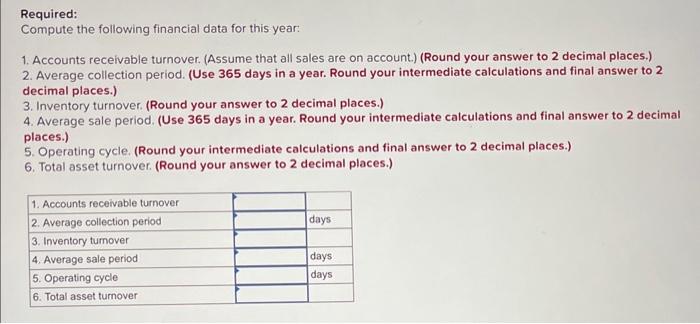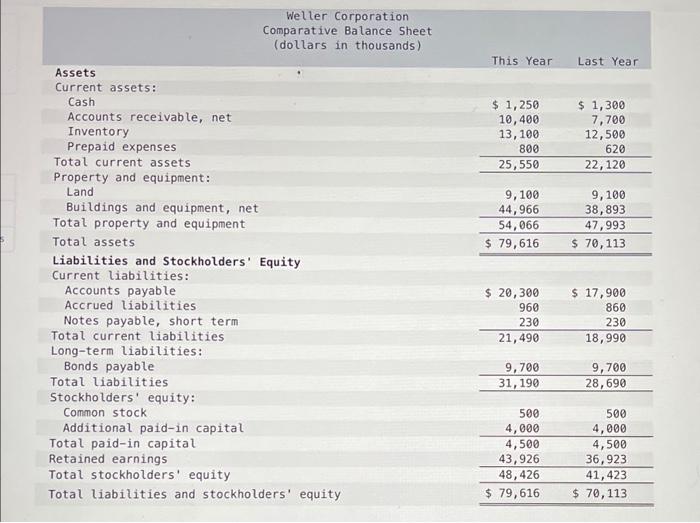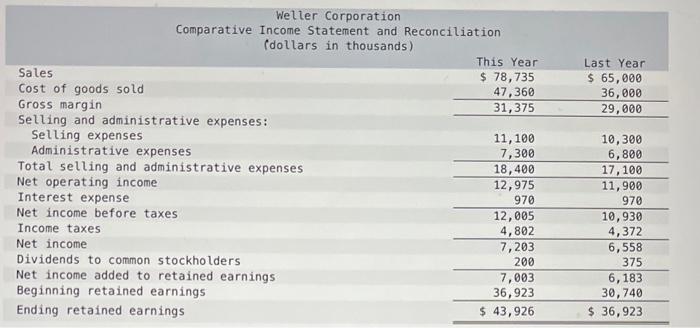Required: Compute the following financial data for this year: 1. Accounts receivable turnover. (Assume that all sales are on account.) (Round your answer to 2 decimal places.) 2. Average collection period. (Use 365 days in a year. Round your intermediate calculations and final answer to 2 decimal places.) 3. Inventory turnover. (Round your answer to 2 decimal places.) 4. Average sale period. (Use 365 days in a year. Round your intermediate calculations and final answer to 2 decimal places.) 5. Operating cycle. (Round your intermediate calculations and final answer to 2 decimal places.) 6. Total asset turnover. (Round your answer to 2 decimal places.) Comparative financial statements for Weller Corporation, a merchandising company, for the year ending December 31 appear below. The company did not issue any new common stock during the year. A total of 500.000 shares of common stock were outstanding. The interest rate on the bond payable was 10%, the income tax rate was 40%, and the dividend per share of common stock was $0.75 last year and $0.40 this year. The market value of the company's common stock at the end of this year was $20. All of the company's sales are on account. Weller Corporation Comparative Balance Sheet (dollars in thousands) Assets This Year Last Year Current assets: Cash Accounts receivable, net Inventory Prepaid expenses Total current assets Property and equipment: Land Buildings and equipment, net Total property and equipment Total assets Liabilities and Stockholders' Equity Current liabilities: Accounts payable Accrued liabilities Notes payable, short term Total current liabilities Long-term liabilities: Bonds payable Total liabilities Stockholders' equity: \begin{tabular}{rr} $1,250 & $1,300 \\ 10,400 & 7,700 \\ 13,100 & 12,500 \\ 800 & 620 \\ \hline 25,550 & 22,120 \\ \hline & \\ 9,100 & 9,100 \\ 44,966 & 38,893 \\ \hline 54,066 & 47,993 \\ \hline$79,616 & $70,113 \\ \hline \end{tabular} Common stock Additional paid-in capital Total paid-in capital Retained earnings Total stockholders' equity Total liabilities and stockholders' equity \begin{tabular}{rr} $20,300 & $17,900 \\ 960 & 860 \\ 230 & 230 \\ \hline 21,490 & 18,990 \end{tabular} \begin{tabular}{rr} 9,700 & 9,700 \\ \hline 31,190 & 28,690 \\ \hline \end{tabular} \begin{tabular}{rr} 500 & 500 \\ 4,000 & 4,000 \\ \hline 4,500 & 4,500 \\ 43,926 & 36,923 \\ \hline 48,426 & 41,423 \\ \hline$79,616 & $70,113 \\ \hline \hline \end{tabular}










